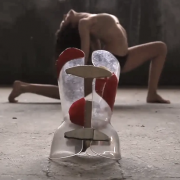A comparison of the Chêneau and Sforzesco braces
Unfortunately, it has become common to think of braces in the same way as we do drugs. But before we go any further, we need to make one thing clear: whereas we all know that aspirin is not the same as paracetamol, in the case of a brace, the name doesn’t really mean anything specific.
A brace is a product that is made-to-measure for the individual patient, and therefore the success of bracing treatment depends not on the name of the brace, but on how correctly it has been constructed for the particular patient. If the pads are incorrectly positioned, or if the brace is constructed so that it sits too low or presses too much on one side, it may even contribute to worsening rather than improving the scoliosis.
The names of the different braces, therefore, are meaningful only to those who prescribe them.
Finally, adding to the confusion, Dr Chêneau gave his name to two completely different types of brace: the first Chêneau is much more symmetrical than the second one, which, on the other hand, is clearly asymmetrical. Although the second Chêneau brace is the one most commonly used worldwide, we prefer to use the first one, for two reasons: first of all, it is discreet (practically invisible under clothes) and second, in constructing it, we are able to apply the same principles that characterise the Sforzesco, which is the brace developed at our own centre. For this reason, the Chêneau that we use at Isico has been given a new name: we call it the Sibilla- Chêneau, in honour of Dr Sibilla, a pioneer of our school.
So, how do the Sibilla-Chêneau and the Sforzesco differ? They differ in several features, which determine the choice of one over the other on a case-by-case basis. The decision to prescribe one type of brace rather than another must always be taken by a medical specialist.
Let’s start with the material: the Sibilla-Chêneau, used at Isico, is of monovalve construction and it is made of polyethylene, whereas the Sforzesco has two valves and is made from a much more rigid material. Its two parts are linked to posterior fasteners, and there is sometimes an aluminium rod at the back, too. Being more rigid, the Sforzesco has shown the same efficacy as the old system of plaster casting, but with the huge advantage of being removable for bathing/showering.
The Sibilla-Chêneau tends to be used to treat milder cases with less rigid scoliotic curves; it is also preferred for pre-pubertal patients. The Sforzesco, on the other hand, is used for more severe scoliosis with more rigid curves (for example, in youngsters with greater bone maturation).
In some cases, patients start off with a Sibilla-Chêneau brace but subsequently switch to a Sforzesco one if the scoliosis becomes too aggressive (a decision reflecting the concept that the treatment should evolve gradually): on a hypothetical treatment scale, we can say that the Sforzesco (a super-rigid brace) is one step up from the Sibilla-Chêneau (a rigid brace).
At Isico, both these braces are prepared in accordance with the SPoRT (Symmetrical, Patient-oriented, Rigid, Three-dimensional) concept of bracing.
“Symmetrical” means that the brace, externally, appears almost perfectly symmetrical, which makes it unobtrusive and helps to replicate the natural shape of the human body. In other words, for aesthetic reasons, it is outwardly symmetrical. By contrast, internally the brace acts asymmetrically, exerting a three-dimensional corrective action on the deformity.
The brace is defined “Patient-oriented” on account of its wearability, and therefore tolerability. Being very closely fitting, it moves with the patient, and it does not restrict arm and leg movements at all. Furthermore, since it is easy to conceal, patients accept it readily, rather than merely putting up with it.
The term “Rigid” refers to the type of material used.
Finally, “Three-dimensional” refers to the corrective action of this type of brace on the spine; technically speaking, the brace pushes in a down-up direction; overall, the transmission of the corrective forces to the spine is carefully balanced in such a way as to obtain optimal correction in all three planes of space, without any of the three being allowed to dominate.
As explained at the start, another type of Chêneau brace is also used worldwide; in Italy, we call this the Chêneau 2000: it is an asymmetrical brace that uses expansion chambers. It remains clearly asymmetrical, even externally. We, on the other hand, prefer to use the symmetrical version of the Chêneau, in order to respect the SPoRT concept mentioned above and also because it favours compliance. Indeed, applying our school of thought, we have obtained, in our patients, the best bracing results recorded anywhere in the world, and this is thanks, in part, to the type of braces we use. Naturally, braces only work if patients actually wear them, and the easier they are to conceal under clothes, the more patients will wear them.

